
Gem-cutter Roger Dery of Spectral Gems has been to the end of the rugged road in rural Africa — and, fortunately, back. His vehicle broke down three times in eight days during one visit. Dery has lost his luggage and had to scrape by with the contents of his backpack. He’s bought gemstones under duress, with 20 people watching his every move.
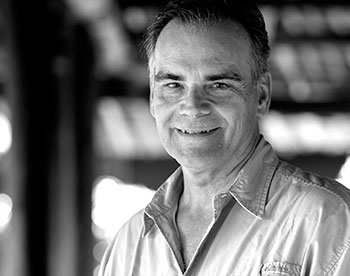
Roger Dery of Spectral Gems takes jewelers to African mines through his program Gemstone Adventure Travel .
Dery has led 55 jewelry retailers to African mines since 2010 through his program, Gemstone Adventure Travel. He was featured in Sharing the Rough, a 2014 documentary about the journey of gems from mine to market directed by Orin Mazzoni, a jeweler and filmmaker. The film traces the path through the supply chain of a single gemstone and touches on the potential of the gem industry in Tanzania and Kenya and the importance of gemological education there. Roger’s been to Africa 25 times; his wife, Ginger, has joined him for nine of those trips.
“Every trip has a theme to it,” Ginger says. “Last summer we saw so many elephants — as many elephants on the one trip that we saw on all of our trips combined, and believe me we’ve seen a lot of elephants. We’re facing in, with the top of the vehicle open, and the driver says ‘Everyone stay seated.’ He had to turn the car in the other direction and keep the engine running. We could easily see a hundred elephants, and then we saw two bull elephants get going with each other. We had this feeling the elephant was going to come after us so we flew out of there.”
Most of Roger’s rookie mistakes were made in the first few trips.
Advertisement
“Those experiences made us realize we need a driver and a guide and a big safari vehicle,” Ginger says. “And after the lost luggage experience, everything goes in carry-ons. We just make it fit.”
Roger admits the trips are off the grid, but he says it’s not really rigorous. “We do walk, and yes, we are in Range Rovers, which are bouncy, but it isn’t like we’re hiking to the top of mountains,” he says.
Dave McConnell of The King’s Jewelers in Walnut Creek, CA, who has traveled with Dery, says conditions are so poor that sometimes the shoulder of the road is easier to drive on than the road itself. “It shocked me. At one point, we’re in a ditch in the road, and even though I’m sitting 5 feet off the ground in a safari vehicle, I was at such an angle in this ditch that I could almost touch the ground.”
Roads turn into trails so narrow that brush scrapes the sides of the vehicles.
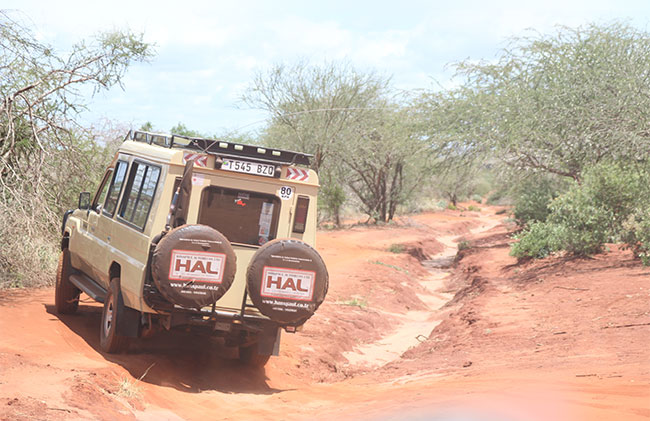
Dave McConnell found road conditions shocking; Here, one of the vehicles in Dery’s group makes its precarious way to a remote mine in Kenya.
Advertisement
“There are no rest stops, few food sources. You have to bring everything in and everything out again. Most of my meals were granola bars that I brought from the States,” he says. He also suffered debilitating food poisoning. Still, he says, it was a very positive experience.
Real-life adventures are common for gem hunters, but adventure isn’t the most important reason to consider traveling in search of precious stones. Rather, it’s the stories retailers bring back to clients. Visiting mines, or buying polished stones close to the source can also be a life-changing experience for jewelry retailers and deepen their connection to what they are selling.
“The first time I went in September 2011 it changed my perception of the industry, my ability to talk about it, my heart for the people, the miners, the kids,” Ginger says. “And so that’s what we want to share with retail jewelers. If it can do that for me, and I live colored stones, what can it do for them, to be able to say, ‘Yeah, I was there. Let me tell you about it. Let me tell you about this school in Africa that we support’?”
Roger encourages retail jewelers to travel — if not to Africa, then within the U.S., to Oregon sunstone mines or Maine tourmaline mines, or the multiple gem shows in Tucson in February. “If clients know you just order something from New York, or LA, that’s not very exciting,” Roger says. “You would like to be able to say, ‘I traveled to this particular mine in Kenya, bought the miners a couple of cases of water and a 5 kilo bag of corn, sat and talked to the guys and had a pretty good feel about what they were going through that day.’
“If you’re not doing that and not going to Antwerp on diamond-buying trips, you’re missing out on how to create the story. It’s the difference between a first-hand experience compared to ‘I picked up the phone and called the gem dealer.”
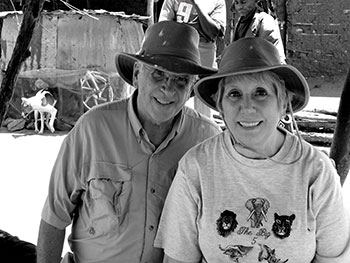
Nancy Schuring and her husband, Joe Portale travel Kenya in search of gemstones.
Advertisement
Nancy Schuring, owner of Devon Fine Jewelry in Wyckoff, NY, has traveled to mines and markets in Brazil, Madagascar, Kenya, Thailand, Hong Kong, Singapore, Israel and Spain to get close to the source of the gems she loves. Africa is not for the faint-hearted, she says.
“It’s not necessarily luxury travel, but in the mountains of Africa, gems are never found near the cities,” she says. “Several times, we’ve had to go with armed guards. But there are dealers in the cities you can meet, which don’t require mine travel.”
For Schuring, gem hunting is a quest well worth the investment of time, energy and money. It helps her educate her staff about lesser-known gemstones. Over the years, she has sold more than 100 different types of gems and expanded her colored gem business greatly. At any one time, she has dozens of varieties in inventory. “I usually keep a globe in the store,” she says. “It’s a nice thing to point to to show where these things are from. It gives another layer of awareness about the gem.
“It adds credibility,” Schuring says. “Meeting the people in the root of our industry brings a lot to your retail situation. When you have walked the walk, you become the expert, and you appreciate what it takes to create the gems we often take for granted.”
Her international quests have also established her business as philanthropic and her sourcing as transparent. She founded the Devon Foundation, which has raised money for dozens of scholarships for residents of Madagascar and Tanzania to learn about gemology. “There’s a whole group of customers out there who choose retail outlets on the basis of social consciousness,” she says. “It’s just another way to differentiate your business.”
COLORED STONE RESOURCES
➤ The American Gem Trade Association website, addmorecolortoyourlife.com, offers a gem palette chart in the gemstone section. AGTA membership comes with a free online product promotion course. See also, agta.org/tradeshows.
➤ Gemstone Adventure Travel, rogerderygemdesign.com . See also sharingtherough.com, for information about the documentary, Sharing The Rough.
➤ Bernie Gaboury, Syner Gem, gemhunter.ca
➤ Ron LeBlanc, gemhunter.com
➤ Loretta Castoro, lorettacastoro.com
➤ International Colored Gemstone Association, gemstone.org
➤ Gemological Institute of America, gia.edu
➤ Canadian Institute of Gemology, cigem.ca
➤ American Gem Society, americangemsociety.org
Gem hunter Ron LeBlanc, whose travels were documented on Gem Hunt, a Travel Channel show that ran from 2013 to 2014, says he has faced unbelievable risks in pursuit of gems for his private collector clients, although lately he’s become more cautious.
“I’ve got a big sack of money with me and everyone around me is looking at how to take that money from me,” he says. “I’ve been robbed a few times. But when you make efforts to be safe and secure, you’re as safe and secure as anywhere.”
The fact that cash is needed for these kinds of transactions is risky in ways beside tempting potential robbers, says gemstone expert Roland Schluessel of Pillar and Stone and author of Mogok-Myanmar. There is a big risk dealers will misrepresent the gems, either through deception or ignorance, and there is no return policy. “The gem business at that level is a cash business, while retailers in the U.S. are used to a memo mentality. You can’t take two or three months to pay.”
If you venture farther afield than Bangkok, you’ll run into more and more synthetics, he warns.
“You have to know your gemology,” he says.
Sellers are savvy, too, and will be able to quickly assess your experience and skill level. “It takes them three seconds,” Schluessel says. “They can tell just by the way you open a plastic bag, with two fingers or four.”
Schluessel says buying at the source has changed in the past few years. “Many years ago you could not go to the mines — with a few exceptions. If you tried it in Tanzania, you would end up in jail. Then came a time, with globalization, where everything opened, when people started to travel and say, ‘Oh, why not go to look at the mines, and buy gems?”
Still, although it is possible to visit mines in exotic locations, with the help of local guides, when retailers talk about buying at the source, that generally means as close as possible in the pipeline to the source. “The retailer is normally looking for cut stones,” Schluessel says. “They don’t usually need rough. And normally a retailer doesn’t need hundreds of stones; he needs one or two stones and makes jewelry out of it. So the closest step to the mine he needs to take is probably a market like Bangkok, or Australia for opal.”
But McConnell does like to buy at the mines and says a $5,000 budget in Africa can go a long way. “You’re going to come back with a lot of gems, and the bang for the buck is really, really good. Some of these gems are much rarer than diamonds and are a fraction of the cost. In Israel, when I go to the diamond bourse, my budget is 20 times higher than what I go to Africa with.”
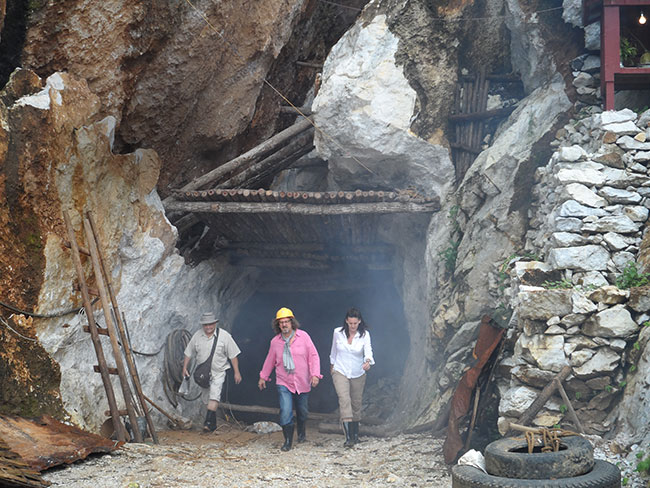
Bernie Gaboury, Ron LeBlanc and Diane Robinson, from left, emerge from a ruby mine in Mogok, Myanmar, that has just been blasted, during filming of the Travel Channel show, Gem Hunt.
His store’s most popular annual event is a gemstone roundtable with Roger Dery.
“How many jewelers can say they’ve been to the mines in East Africa and bought gems from the miners?” McConnell says. “To see this thing from the mine to my final market here has been invaluable. And it really has encouraged me about the industry in general. There’s been so much bad press about mining conditions and blood diamonds. I can’t deny it has gone on, but the good I saw being done with schools built for miners’ kids is phenomenal and encouraging. It helps me address concerns when people come in to the stores with questions about child miners. Governments are beginning to step in to make sure mines are built correctly so they are safe. Having photos and videos in the store from my trips gives me a level of transparency that most stores can never have.”
Schluessel, too, sees great value in retailers visiting mines as a learning experience and a source of inspiration and confidence.
“You can immediately identify the retailers or the salespeople who have been in a gem mine once or twice,” Schluessel says. “The stone takes on another dimension. It becomes something that comes out of nature, and they can talk about it completely differently.”
Gemologist Bernie Gaboury, who traveled with LeBlanc and appeared on Gem Hunt, has gotten mugged in Bogota, Colombia, and has fallen ill all over the world. “A lot of these places are nasty,” he says. “It’s not for the average person. As far as going into the wilds and finding things yourself, you’re not going to do that in most countries.”
Gaboury says people he’s met have gone to any lengths to make a deal.
“I’ve had fluorite passed off to me as emerald,” he says. “You’ve got to have a certain arsenal of tools that helps you determine what you are looking at. I’ve seen people take synthetic sapphire and shape them into a natural shape and push dirt into cracks to make them look natural. They will go to any end because it could mean two years of feeding their family. That’s the sad part. But I’m out of pocket myself, and I’m there to find something that has some value.”
The lure of the treasure hunt can be powerful, even when there are risks and inconveniences.
“There’s something in human nature,” Gaboury says, “that makes the appeal of gem hunting, of treasure hunting, almost like a fantasy. At one time rock hounding used to be one of the biggest American family pastimes, especially for people traveling. I don’t think there’s anybody who doesn’t like treasure hunting, the idea of finding something special. That’s what propelled me to do what I do.”
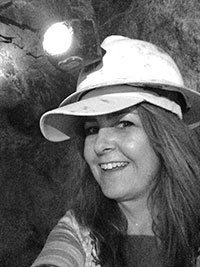
“I have gone to some really far out places and I’ve been in a couple of scary situations.” — LORETTA CASTORO
Loretta Castoro, gemologist and jewelry designer, has hopped around the globe in search of the perfect stones. She describes herself as very adventurous and also very lucky.
“I’m going to knock on wood,” she says. “I have gone to some really far out places and I’ve been in a couple of scary situations. I’m going to credit the people I’ve traveled with for having great experiences. We were in a situation where we were in a country that was military-controlled and our cars kept breaking down. Two of three of the cars broke down and we had quite a large group of people. We were just stuck on the side of the road in the jungle for a while, and I wandered off a little bit because I thought the scenery was so beautiful. A guide came running after me and pulled me back in. In some countries, they don’t want you to see certain things and you only get access because you will be with very specific people who will take you only to specific places. I realized you can get in trouble if you wander off. Stay with your group!”
Castoro cautions that getting to the mines doesn’t mean you’ll find the best purity and value. You have to have the knowledge to know what you’re looking at.
“When you’re at a mine it doesn’t mean you’re going to be looking at genuine gemstones or even gemstones that are from that mine,” she says. “When I was in Myanmar, in Mandalay, they have a jade market, and anyone can go there. But I saw more fake jadeite there than I’ve seen anywhere. There are a lot of synthetics, fakes, simulants and treatments at the mines. You have to know what you’re looking at and how it’s been treated, whether it’s rough or cut, because I’ve seen rough pieces that are synthetics as well.”
LeBlanc, who grew up poor in a small Canadian town, was drawn to gem hunting through a fascination with beauty, wealth and travel.
“I knew the world beyond my small town was full of magic and creativity, that the outside world was full of goodies. Travel was all about treasure and the big life, of which I was enamored as a poor kid. There was something about beauty that completed something missing in me.”
Decades ago, traveling to Morocco with a wealthy friend, LeBlanc purchased some stones in a market that a friend later said were worthless. “I threw them into the parking lot and I said ‘I will never be caught again wanting in knowledge of any toys of the rich. So I went to GIA and here I am 40 years later. Everything to me is about beauty.”
For LeBlanc, going to the source is not optional. “I have to go,” he says. “That’s my covenant with the clients. They need the provenance, they need the story, and they need the price. Story is everything. When I sell a gem to my high-net-worth people, they aren’t bragging about buying more stocks or buying more oil; they are saying, I bought a gem from a gem hunter!
“Value is fickle, but stories are eternal. Gems are better than stock, better than a Jag, better than most real estate.”

Dave McConnell and miners rest in the shade after a visit to a mine in Kenya.